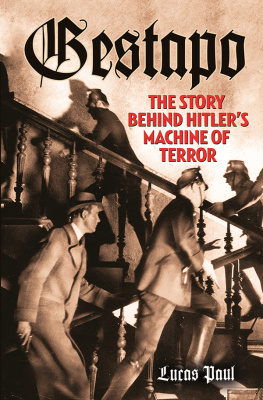Foundations of the
Nazi Police State
To MY MENTORS
without whom this would never have been begun.
To ETTA
without whom it could never have been finished.
Foundations OF THE Nazi Police State
The Formation of Sipo and SD
GEORGE C. BROWDER
Publication of this volume was made possible in part by a grant from the National Endowment for the Humanities.
Copyright 1990 by The University Press of Kentucky
Paperback edition 2004
The University Press of Kentucky
Scholarly publisher for the Commonwealth, serving Bellarmine University, Berea College, Centre College of Kentucky, Eastern Kentucky University, The Filson Historical Society, Georgetown College, Kentucky Historical Society, Kentucky State University, Morehead State University, Murray State University, Northern Kentucky University, Transylvania University, University of Kentucky, University of Louisville, and Western Kentucky University.
All rights reserved.
Editorial and Sales Offices: The University Press of Kentucky
663 South Limestone Street, Lexington, Kentucky 40508-4008
www.kentuckypress.com
The Library of Congress has cataloged the hardcover edition as follows:
Browder, George, C., 1939
Foundations of the Nazi police state : the foundation of Sipo and SD / George C. Browder.
p. cm.
Includes bibliographical references.
ISBN 0-8131-1697-X :
1. Nationalsozialistische Deutsche Arbeiter-Partei. Schutzstaffel. SicherheitspolizeiHistory. 2. Nationalsozialistische Deutsche Arbeiter-Partei. Schutzstaffel. SicherheitsdienstHistory. 3. Nationalsozialistische Deutsche Arbeiter-Partei. SchutzstaffelHistory. 4. Himmler, Heinrich, 19001945. 5. GermanyPolitics and government19331945. I. Title.
DD253.6.B78 1989
363.283094309043dc20 89-22618
Paper ISBN 0-8131-9111-4
This book is printed on acid-free recycled paper meeting the requirements of the American National Standard for Permanence in Paper for Printed Library Materials.
Manufactured in the United States of America.
| Member of the Association of American University Presses |
Contents
[Illustrations follow ]
Power Structure of the Third Reich
This composite chart portrays the relationship of Sipo and SD to the power structure of the Third Reich as it existed in 1936. Dates in parentheses indicate additions to this structure after the NS acquisition of power in January 1933. Only agencies discussed in this book are listed. See the list of abbreviations beginning on .
Figures
Acknowledgments
With a work that has taken so long and led to so many places, the list of indebtedness becomes so great that there is some hesitation to publish it, out of fear of omission. If I have omitted someone, I hope he or she will be as forgiving as he or she was helpful, and understand that I am in no way ungrateful. For the numerous archivists who so generously hosted me, tolerated my rapacious demands, and then waited endless years to see any results, it seems hardly fair to be acknowledged merely in the collective, but space simply does not allow a listing of all their names.
The list of indebtedness must begin with Robert L. Koehl, who introduced me to the subject and nursed me through the initial trauma of negotiating a sea of microfilmed documents. His manuscript, which he generously made available long before its publication, was an indispensable thread through the labyrinth of primary and secondary sources.
Not only is the work of Shlomo Aronson a major contribution to high-quality scholarship in the field, but he has also been most generous in providing copies of correspondence and other materials from surviving members of Sipo and SD. The same is true of David Kahn and Peter Black.
Of course, no work of this nature would be possible without the full support and the diligent work of Robert Wolfe and his staff at the National Archives. The vast facilities and the services of the Bundesarchiv, its various branches, and the many Land archives in the Federal Republic of Germany made possible years of work in mere weeks or months. No scholar of modern German history need be told of the quality of their contribution, but I feel a special debt for both their patience and their professional dedication. In addition to the federal archives, specific mention is due the Geheime Staatsarchiv Berlin-Dahlem; the Politisches Archiv des Auswaertigen Amtes; the Bayerisches Hauptstaatsarchiv, Munich; the Bayerisches Staatsarchiv, Munich; the Staatsarchiv, Bremen; the Niedersaechsische Staatsarchive in Wolfenbuettel, Oldenburg, Hannover, and Bueckeburg; the Hessisches Hauptstaatsarchiv Wiesbaden and Staatsarchiv, Darmstadt; Staatsarchiv Detmold; Hauptstaatsarchiv Stuttgart; and Staatsarchiv Ludwigsburg. The staffs of the Institut fuer Zeitgeschichte, the Generalstaatsanwaltschaft bei dem Kammergericht Berlin, and the Polizei-Fuehrungsakademie Hiltrup gave assistance that was most appreciated. The late Richard Bauer and his successor, Daniel Simon, and the staff of the U.S. Document Center in Berlin made it possible to locate and review the files of hundreds of former members of Sipo and SD. Their patient and friendly service made pleasant the otherwise interminable periods of monotony between discoveries.
It is no longer possible to construct a complete list of the libraries to which the author is indebted. Most central, however, have been the services of the library of the University of Wisconsin at Madison and the Reed Library of the State University of New York, College at Fredonia. Special thanks must go to the staff working on interlibrary loans at both institutions.
Without financial backing, no scholar can manage the expenses of research across the oceans, far from home. In this respect, I am especially indebted to the National Endowment for the Humanities and to the Research Foundation of the State University of New York, both of which contributed significantly to foreign travel and extensive stays abroad. The Committee on Research and Creativity, the Department of History, and the administration of the College at Fredonia also came through to fill the innumerable cracks that are a drain on resources.
The late Harold Gordon and Charles Sydnor, Jr. deserve special mention for having waded through the entire manuscript in its earlier draft and for providing invaluable criticism. Patrick Courtss reading and suggestions at intermediate stages inspired much-improved clarity. David Kahn and George Stein read one or more chapters and applied their special knowledge to the improvement of each. Douglas Shepard helped refine the final drafts. The invaluable editorial assistance of Sharon Ihnen provided the finishing touches. Needless to say, what is good in this book owes much to their assistance, but they have no responsibilities for its problems, shortcomings, or errors. I was unable to incorporate all of their advice or solve all of the problems they uncovered.














